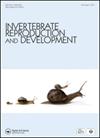Spawning and gravidity of the endangered freshwater mussel Epioblasma capsaeformis (Bivalvia: Unionidae) in captivity for production of glochidia
IF 0.8
4区 生物学
Q4 REPRODUCTIVE BIOLOGY
引用次数: 3
Abstract
ABSTRACT Understanding the reproductive biology of the endangered Epioblasma capsaeformis of the eastern United States is critical to conservation efforts at mussel hatcheries. We studied how males influenced gravidity among females held in captivity. Percent males (0%, 33%, 50%, and 67%) within a holding system was used as the predictor variable. Our response variables were percent females observed gravid, number of eggs and glochidia per gravid female, total eggs (sum of eggs and glochidia) per gravid female, and proportion of total eggs successfully fertilized and developed into glochidia. Mean percent of females gravid in the male treatments were 73%, 85%, 69%, and 60%, respectively, with no evidence that treatments differed significantly from one another. However, the treatment without males had significantly lower mean number of total eggs observed (4,533 vs. 5,868 to 7,330), with fewer viable glochidia (1,354 vs. 5,645 to 6,920). Most of the eggs in the treatment without males were unfertilized at experiment completion (3,179 vs. 206 to 410), with a much lower percentage of transformed glochidia (27% vs. 94 to 97%). Our study documents the important role that males play in fertilizing females for production of glochidia and that key reproductive processes occurred in captivity.濒危淡水贻贝Epioblastma capseformis(双壳目:单壳目)的繁殖和妊娠
摘要了解美国东部濒临灭绝的辣椒扁球藻的繁殖生物学对贻贝孵化场的保护工作至关重要。我们研究了雄性对圈养雌性妊娠的影响。持有系统内的男性百分比(0%、33%、50%和67%)被用作预测变量。我们的反应变量是观察到的妊娠女性百分比、每只妊娠女性的卵子数量和球壳数量、每只怀孕女性的总卵子(卵子和球壳总数)以及成功受精并发育成球壳的总卵子比例。在男性治疗中,女性怀孕的平均百分比分别为73%、85%、69%和60%,没有证据表明治疗之间存在显著差异。然而,在没有雄性的治疗中,观察到的平均总卵子数显著较低(4533个对5868个至7330个),存活的球壳虫较少(1354个对5645个对6920个)。在没有雄性的处理中,大多数卵子在实验完成时都没有受精(3179对206至410),转化的球壳虫的百分比要低得多(27%对94至97%)。我们的研究记录了雄性在为雌性受精以生产球藻方面发挥的重要作用,以及圈养条件下发生的关键繁殖过程。
本文章由计算机程序翻译,如有差异,请以英文原文为准。
求助全文
约1分钟内获得全文
求助全文
来源期刊
CiteScore
1.90
自引率
0.00%
发文量
21
审稿时长
>12 weeks
期刊介绍:
Invertebrate Reproduction & Development ( IRD) presents original research on the reproductive and developmental biology of the Invertebrata, both embryonic and postembryonic. IRD welcomes papers reporting significant results obtained using new techniques. Encouraged topic areas include: aquaculture, physiology, biochemistry, functional morphology, phylogeny, behavioural and regulatory mechanisms, including genetic, endocrine and molecular studies. Papers containing qualitative descriptions of reproductive cycles and gametogenesis will not be considered. IRD is published in association with the International Society of Invertebrate Reproduction and Development.

 求助内容:
求助内容: 应助结果提醒方式:
应助结果提醒方式:


